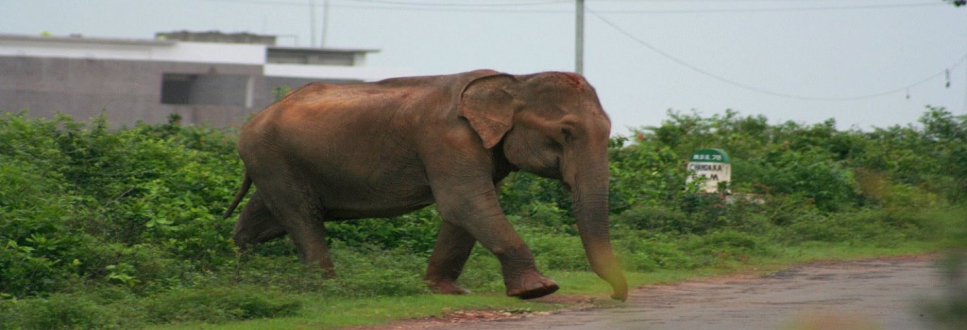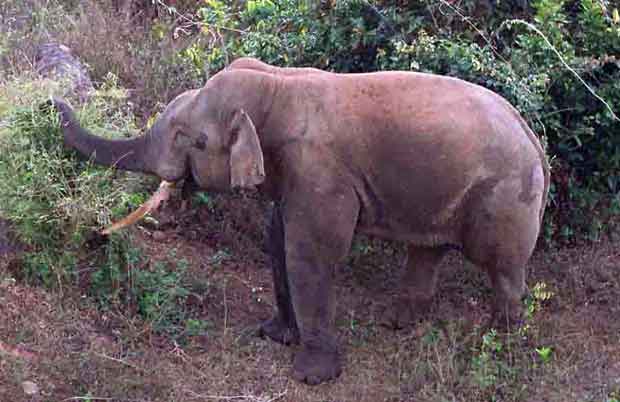Wildlife Corner
A tusker in ‘musth’ in the Chandaka Wildlife Sanctuary on the outskirts of Bhubaneswar |
TASK FORCE ON PROJECT ELEPHANT CONSTITUTED BY GOVERNMENT OF INDIA The Task Force on Project Elephant held a meeting with stakeholders at Bhubaneswar recently. Wild Orissa was invited to participate. In this regard Mr. Shibaji Charan Nayak, [Program Head Wild Elephants Conservation- Wild Orissa] represented Wild Orissa. The suggestions/comments/recommendations/views of Wild Orissa (enclosed), on the Terms of Reference of the Task Force on Project Elephant constituted by the Government of India were presented during the deliberations. SUGGESTIONS/RECOMMENDATIONS FOR TASK FORCE ON PROJECT ELEPHANT- WILD ORISSA It is important India's elephants are given their due place. Orissa is one of the elephant range areas which needs to be taken up on priority. We at Wild Orissa have been closely working with the Orissa Forest Department on the conservation of wild elephants as per our capacity. We have regularly been participating in wildlife enumeration exercises and undertaken wild elephant conservation initiatives. ISSUES ON WILD ELEPHANT POPULATION IN ORISSA 1. Large scale diversion of wild elephant habitat- This was seen recently when clearances were given to industrial and infrastructure projects in northern areas of Orissa viz. Sambalpur, Jharsuguda, Sundargarh, Bargarh, Jajpur, Keonjhar. The issue gets further aggravated as wildlife plans prepared and submitted at the time of obtaining forest clearance are not implemented. Rampant industrialisation in Angul and Keonjhar districts has forced many elephants from these regions to migrate into the less industrialized Dhenkanal division, causing an unnatural population high in the region and severely aggravating human-elephant conflict. 2. Insensitive approach at the time of considering forest clearance proposals- There have been numerous instances when movement paths of elephants and their home range are being not placed on record. 3. Orissa with an aggressive industrial push will loose its elephants in the wild excepting those limited in forests like in Satkosia, Similipal, etc. We have had the occasion to study in detail reports by Dr. D.K.Lahiri Choudhari, IISc Bangalore, etc. apart from our own field inputs. All go to show that movement paths of wild elephants in Orissa have already been severely restricted. 4. An age-old movement corridor viz. Chandaka-Athgarh-Kapilas-Satkosia-Ushakothi have been severely fragmented at a number of places, with the result that at least 6-7 different isolated populations have emerged even as recently as in the past 3-5 years. 5. The Baitarani Elephant Reserve and South Orissa Elephant Reserve, which were proposed by the state government and had even received informal approval from the Government of India, are being shelved by the Government of Orissa. These are extremely critical elephant habitats, as they will preserve the connectivity between the Similipal-Mayurbhanj-Saranda and the Satkosia-Boudh-Ushakothi-Phulbani-Ghumsar-Lakhari populations. Despite severe pressures on habitat from mining, roads, anthropogenic pressures, etc Orissa is fortunate to still have relatively good connectivity of tiger and elephant habitats in a north-southerly direction throughout the length of the state. The two single largest intact elephant populations, numbering between 400-500 elephants each in the Mahanadi Elephant Reserve in central Orissa (based around Satkosia Tiger Reserve) and Mayurbhanj Elephant Reserve in north Orissa (based around Similipal Tiger Reserve) have been isolated from each other only very recently in history. These two habitats were connected through the Ushakoti-Badrama forests and Keonjhar-Daitari forests. This connectivity has been broken fairly recently in history by the construction of the Rengali canal, rampant mining and mindless industrialisation in these regions, especially Angul and Keonjhar districts, and even, in cases, thoughtless use of solar fencing. Apart from isolating the large populations of Similipal and Satkosia, this has also ended up fragmenting smaller populations ranging between 40 and 100+ in areas like Ushakoti Wildlife Sanctuary, Keonjhar Division, Kapilas Division, etc. This connectivity can still be revived and if this can be achieved, a huge elephant gene pool numbering at present somewhere close to 1500 individuals, in a vast pan-Orissa landscape from Mayurbhanj down to Ghumsar-Lakhari through Keonjhar, Ushakoti-Badrama (Khalasuni), Satkosia-Baissipalli and Phulbani can be connected and form an immense contiguous population effectively securing the future of the species in this part of the country. It needs to be noted that the Mayurbhanj Elephant population is connected with the south Bengal and Jharkhand elephant populations. 6. The Chandaka Wildlife Sanctuary has suffered irreparable damages since the last few years. We are continuously observing elephants rejecting this habitat and moving outside and entering into man-animal conflicts. So much so that when, as recently as 2002, about 85+ individuals were perhaps contended to remain within the confines of the 185 sq.kms protected area, today this number is less than 10-20 in most months. A very disconcerting aspect has been all this is after construction of elephant proof trenches all around. The reason is the severe degradation of habitat inside the Chandaka-Dampara WLS over the last few years. Severe anthropogenic and developmental pressures have been seen during the last few years, when once with stringent efforts of the DFO and other forest staff this area had retrieved itself from the difficult days of early 1980's. This protected area which was on a revival path until 2005-6, is facing the most difficult times with increasing numbers of people and cattle inside its precincts. It will be important to declare areas around the Chandaka-Dampara WLS as Eco-sensitive Zone. 7. Authorities have been attempting to undertake mitigation of elephant-human conflict on debatable procedures. It has been learnt that certain states are implementing externally aided assistance projects without considering issues like voluntary relocations of people, provision of securing critical habitats, re-establishing corridors, etc. Interestingly promotion of eco-tourism features very high on the list and that too in elephant and tiger sensitive habitats. 8. The ongoing left extremism problem in Orissa has aggravated the situation. The authorities are considering construction of highways cutting through prime elephant and tiger habitats in Orissa to combat the naxal menace. While the decision for construction of highways as a strategy to fight extremists needs to be examined, the effects of such a step, if carried out without taking into account the deleterious impacts on Orissa’s tiger and elephant populations, could be catastrophic. It will be appropriate that these aspects are placed on record. 9. Rampant illegal mining, as reported during recent months in Orissa, is mostly in elephant habitats. The severe damage caused to wild elephant populations and their habitat has remained undocumented in office records. 10. There is a big difference in perception and information gathering between official statistics of wild elephant deaths and those featured by the press and media! Recent instances are extremely heart-rending.
RECOMMENDATIONS & SUGGESTIONS 1. Consolidate immediately elephant areas outside Protected Areas, Tiger Reserves and Elephant Reserves. 2. Bring on board reports by DK Lahiri Choudhury, IISc, WTI, etc. on wild elephant corridors and examine changes in Profile of elephant forest areas over the decades by considering similar past reports. 3. Environmental Impact Assessments needs to consider existing reports. 4. Strengthen the Orissa Forest Department’s Wildlife Wing by new recruits, who need to be continuously on patrol, monitoring elephant herds. 5. Assess the damage on elephants and elephant habitats due to illegal mining. 6. Notify more Elephant Reserves including the shelved Baitarani ER and South Orissa ER. 7. Offer industrial rates of compensation for voluntary relocations from critical wild elephant habitats and from migratory paths and corridors. 8. Consider elephant specific measures in formulation of wildlife plans in the forest diversion proposals. A multidisciplinary body could monitor implementation of wildlife plans. 9. Crackdown on and neutralise the well established professional elephant poaching mafia based out of Narsinghpur-Badamba region in Cuttack district. 10. Formulate State level Elephant Plans by consulting stakeholders including credible organizations both from the governmental and non governmental sector. 11. Declare areas around major elephant habitats as Eco-Sensitive Zones 12. Bring in amendment to the Wildlife Protection Act 1972 by providing legally recognized status to the Elephant Movement and Migratory Corridors.
Govt sets up
Task Force on Project Elephant
|








